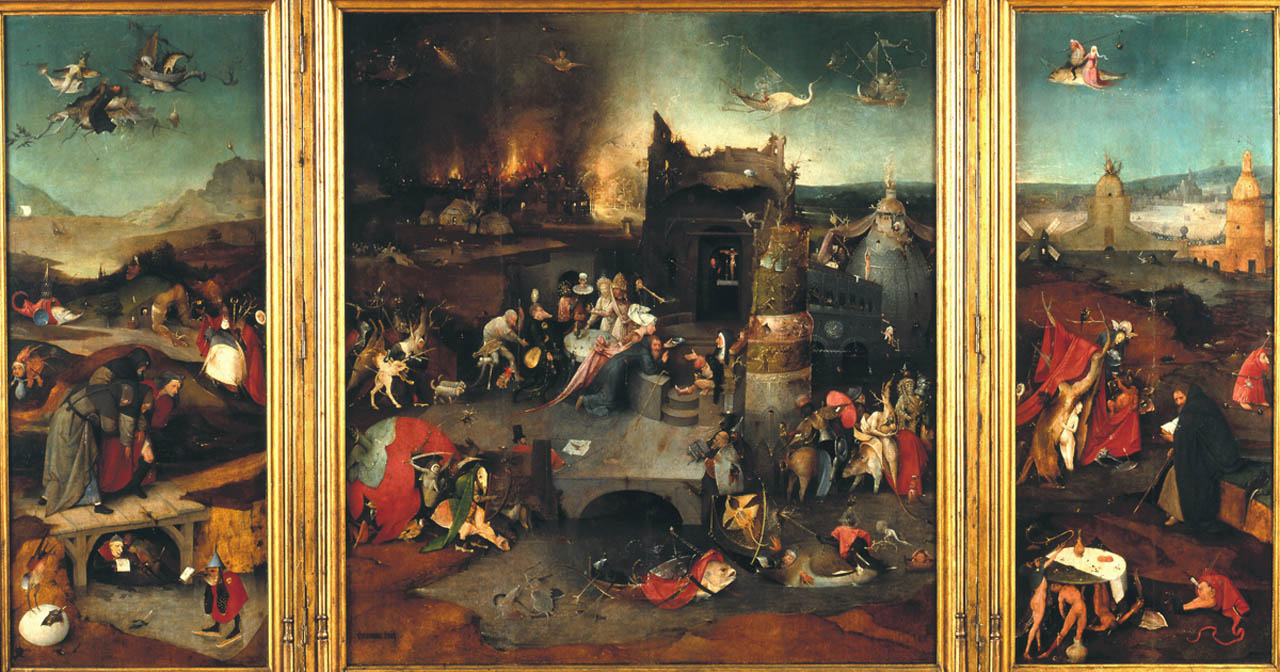Hieronymus Bosch
(c.1450–1516, Early Netherlandish)
He surnamed himself after the town of 's-Hertogenbosch, where he was born.
Death and the Miser
 |
| Dead and the Miser - Hieronymus Bosch - oil on oak panel (93 x 31 cm) 1485-1490 - National Gallery of Art (Washington, D.C.) |
Part of a triptych, it is a memento mori painting, meant to remind the viewer of the inevitability of death and the futility of the pursuit of material wealth, illustrating the sin of greed.
 |
| The Garden of Earthly Delights - Bosch - oil on triptych altar panel (205.5 x 385 cm) 1490-1500 - Museo del Prado (Madrid) |
The Garden of Earthly Delights
(L) Paradise where God chats with Adam & Eve,
(C) Various Delights on Earth,
(R) Sufferings in Hell (where it is alleged that Bosch's self-portrait is in the upper centre at right under the "table".)
Detail: symbolizing youth is a spring with a blue tower, gathering wishers for rejuvenation
Detail: females alluring males riding on animals to join them in lake of happiness. |
| The Ship of Fools - Bosch - oil on wood (58 × 33 cm) c.1490-1500 - Louvre (Paris) |
Christ Carrying the Cross
 |
| Christ Carrying the Cross - Bosch - oil on panel (57 × 32 cm) c.1490-1500 - Kunsthistorisches Museum (Vienna) |
Others in Dutch clothing of the 15th century.
Triptych of the Temptation of St. Anthony
 |
Triptych of the Temptation of St. Anthony - Bosch - oil on wood (131.5 × 225 cm) 1505-06 - Museu Nacional de Arte Antiga (Lisbon) |
Detail of the left panel
showing St Anthony supported by
two monks and a lay-man:
Detail of the central panel
including the man in a top hat
Detail of the right panel
showing the table of luxury:
 |
| The Haywain Triptych - Bosch - oil on oak panels (135 × 200 cm) c.1516 - Museo del Prado (Madrid) |
When the two wings of The Haywain Triptych are flipped to shut it, their painted backs form a single scene depicting a wayfarer (see below).
Around him is a series of miniatures including the robbery of another wayfarer and a hanged man. The man uses a stick to repel a dog.
 |
| The Path of Life (aka The Pedlar) - Hieronymus Bosch - oil on panel (135 x 90 cm) 1510-16 - Museo del Prado (Madrid) |
Hieronymus Bosch statue
- August Falise
- bronze (220 cm) 1929
- 's Hertogenbosch, Noord-Brabant (NL)
- August Falise
- bronze (220 cm) 1929
- 's Hertogenbosch, Noord-Brabant (NL)
- 's Hertogenbosch, Noord-Brabant (NL)
Source: Wikipedia
In the late 16th century, Philip II of Spain acquired many of Bosch's paintings. A few others stay elsewhere.
With the Protestant Reformation, his paintings in the Netherlands were destroyed.


_-_WGA2599.jpg/400px-Hieronymus_Bosch_-_Triptych_of_Temptation_of_St_Anthony_(detail)_-_WGA2599.jpg)





No comments:
Post a Comment